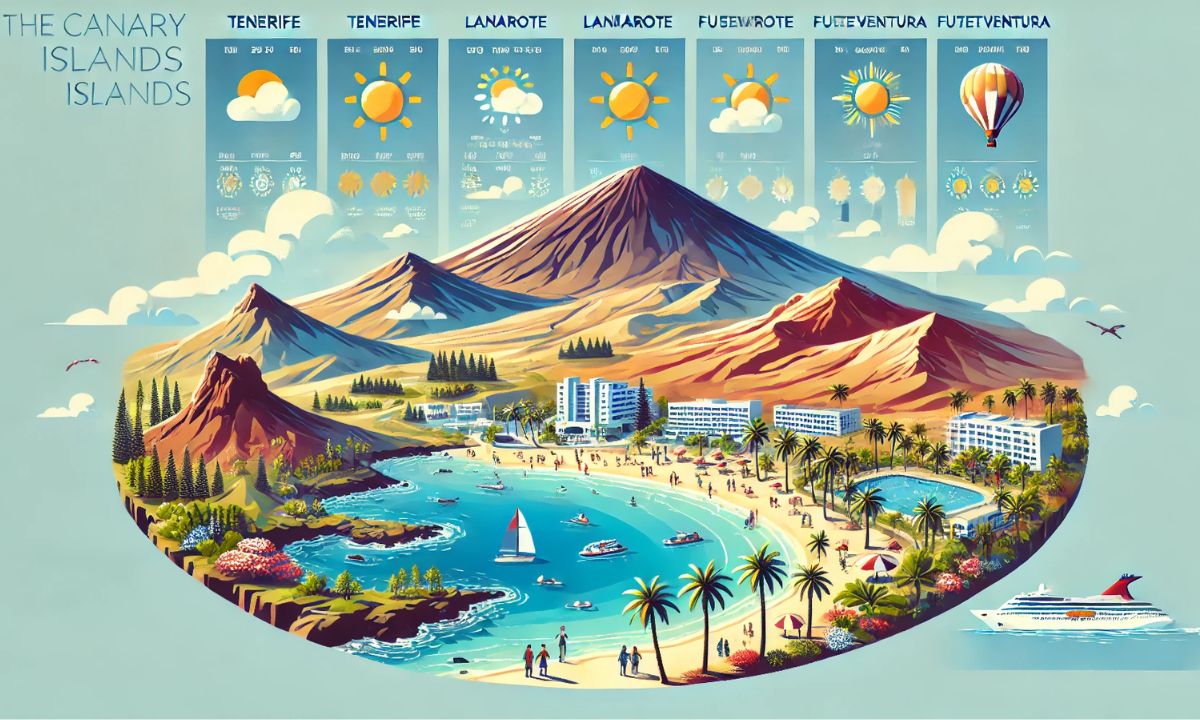Introduction
The Canary Islands are renowned for their stunning landscapes, year-round sunshine, and vibrant culture. Comprising eight diverse islands—Tenerife, Lanzarote, Fuerteventura, Gran Canaria, La Palma, La Gomera, El Hierro, and La Graciosa—each offers unique experiences.
Whether you’re seeking adventure, relaxation, or cultural immersion, the Canary Islands cater to every traveler. Understanding the weather and the best time to visit is essential for maximizing your holiday experience. Popular keywords include “Canary Islands vacation,” “year-round sunshine,” and “best time to visit Canary Islands.”
Weather Overview

The Canary Islands enjoy a sub-tropical climate, making them a favored destination throughout the year. The climate varies slightly across the islands, influenced by their proximity to the African continent and the Atlantic Ocean.
Warm winters and mild summers ensure that visitors can explore the islands’ diverse attractions in comfort. Keywords such as “Canary Islands climate” and “weather in Tenerife” are relevant.
| Month | Average Temperature (Low/High) | Rainfall (mm) |
| January | 17°C / 21°C | 21 |
| August | 24°C / 29°C | 0 |
| October | 20°C / 26°C | 11 |
Climate Zones of the Canary Islands
Different islands and regions within them experience microclimates due to variations in elevation and geography. Understanding these zones can help travelers choose their ideal destination.
Northern Tenerife: Cooler and wetter compared to the south, influenced by trade winds.
Southern Tenerife: Warm and dry, popular for beach holidays.
Gran Canaria: Known as a “miniature continent,” the climate ranges from dry desert-like regions in the south to lush green areas in the north.
Fuerteventura and Lanzarote: These islands are known for their arid landscapes, minimal rainfall, and strong winds.
La Palma, La Gomera, and El Hierro: Cooler, greener, and excellent for hiking enthusiasts.
Best Time to Visit the Canary Islands

Choosing the best time to visit depends on your preferences for activities, weather conditions, and crowd levels.
Spring (March to May)
This season offers mild temperatures and fewer tourists, making it ideal for sightseeing. Exploring national parks like Teide in Tenerife or Timanfaya in Lanzarote is more enjoyable without the summer heat. Consider using keywords like “spring in Canary Islands” and “best time for sightseeing.”
Summer (June to September)
Perfect for beach lovers, summer brings warm waters and sunshine. Temperatures hover around the high 20s, ideal for watersports and sunbathing. Tenerife’s Playa de Las Teresitas and Fuerteventura’s Corralejo Beach are popular spots. Include keywords such as “Canary Islands summer weather” and “best beaches in Canary Islands.”
Read this bloghttps://www.sovereign.com/holidays/spain/canary-islands/weather-in-the-canary-islands/
Autumn (October to November)
A blend of warm weather and thinning crowds makes autumn a balanced choice. It’s an excellent time for hiking and cultural exploration. Keywords like “autumn travel Canary Islands” are useful here.
Winter (December to February)
Escape colder climates by visiting during winter. Temperatures remain pleasant, particularly in Lanzarote and Gran Canaria, which are among the warmest islands. Use keywords like “Canary Islands winter sun” and “warm destinations in winter.”
| Season | Ideal Activities | Crowd Level |
| Spring | Sightseeing, hiking | Low |
| Summer | Beaches, watersports | High |
| Autumn | Hiking, cultural festivals | Moderate |
| Winter | Relaxation, beach holidays | Low |
Island-Specific Weather Highlights
Tenerife
Known for its diverse microclimates, Tenerife boasts warm southern beaches and cooler northern regions. The average temperature in August reaches 25°C, while January sees around 20°C. Keywords like “Tenerife weather” and “Teide National Park” can boost visibility.
Gran Canaria
Often referred to as a “miniature continent” due to its varied landscapes, it’s warmest in February with temperatures averaging 20°C.
Lanzarote
Close to the Sahara Desert, Lanzarote is the hottest island, especially in August. Its volcanic terrain and clear skies attract nature enthusiasts.
Fuerteventura
Known for strong winds, it’s a favorite for windsurfing. It experiences slightly more rainfall than other islands.
Use keywords such as “Gran Canaria weather in winter,” “Lanzarote summer temperatures,” and “Fuerteventura windsurfing.”
| Island | Notable Climate Feature | Best Month to Visit |
| Tenerife | Diverse microclimates | April – September |
| Gran Canaria | Warm winters | February |
| Lanzarote | Hottest temperatures | August |
| Fuerteventura | Windy conditions | June |
Outdoor Activities and Weather Considerations

Beach Holidays
The best beaches are ideal from June to September. Playa de las Canteras in Gran Canaria and Papagayo Beach in Lanzarote are popular.
Hiking Adventures
La Palma’s Caldera de Taburiente and La Gomera’s Garajonay National Park are excellent in spring and autumn.
Watersports
Windsurfing and surfing are best in Fuerteventura and Lanzarote. Winter months also bring larger waves.
FAQs
When is the best time to visit the Canary Islands?
The best time depends on your preferences. Summer (June to September) is perfect for beach holidays, while spring (March to May) and autumn (October to November) are ideal for sightseeing with fewer crowds.
What is the best time for beaches in the Canary Islands?
June to September offers warm temperatures and comfortable sea conditions, making it the prime beach season.
Is it warm in the Canary Islands all year round?
Yes, thanks to their sub-tropical climate, the islands remain warm throughout the year. August is the hottest month, while January and February are the coolest.
Does it rain in the Canary Islands?
Rain is minimal. June is the driest month, and October sees the most rainfall. Fuerteventura generally receives more rain than the other islands.
Which is the quietest time to visit the Canary Islands?
January to March offers quieter holidays with pleasant weather. La Gomera and La Palma are especially tranquil, free from mass tourism.
Conclusion
The Canary Islands, with their diverse climates and landscapes, offer something for everyone. From sun-drenched beaches to volcanic adventures, timing your visit can significantly enhance your experience.
Whether you seek vibrant summer festivities or peaceful winter escapes, these islands promise unforgettable memories. Include terms like “Canary Islands travel guide” and “best holiday destinations in Spain.”
Read more informationhttps://techyspirtz.com/
Visit my other websitehttp://verbvictories.online

David is a seasoned SEO expert with a passion for content writing, keyword research, and web development. He combines technical expertise with creative strategies to deliver exceptional digital solutions.














